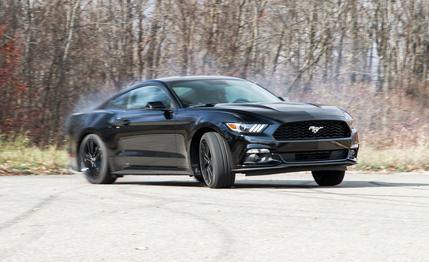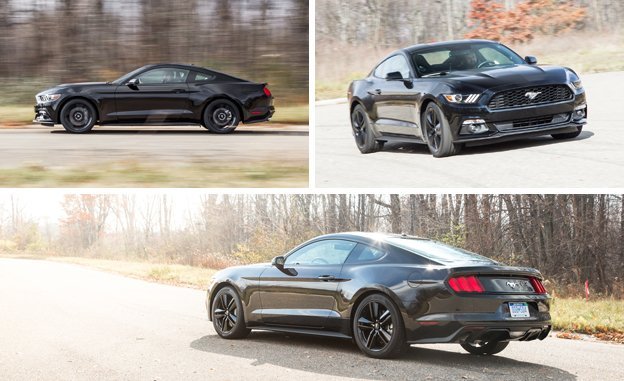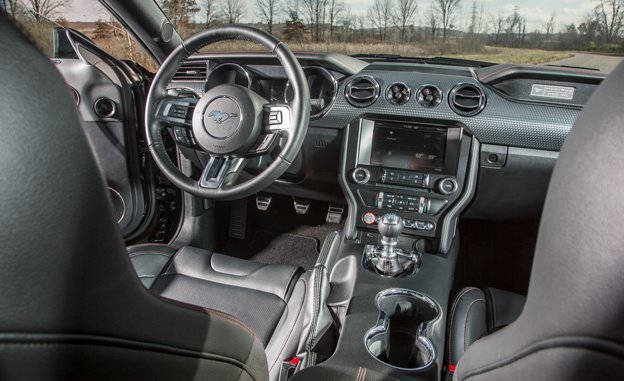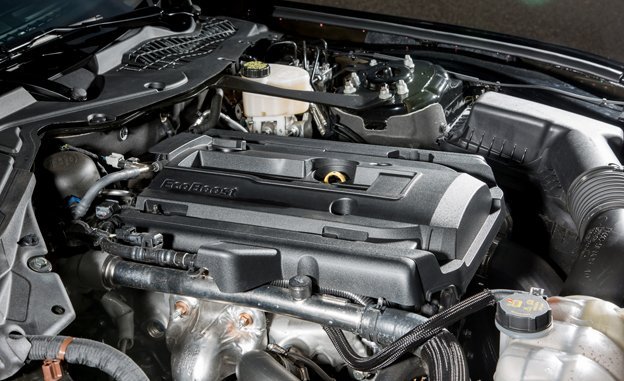 Instrumented Test
From the April 2015 issue
Instrumented Test
From the April 2015 issue
If you were surprised when Ford sent us the first turbo four-banger Stang in three decades for a November-issue road test and it showed up with an automatic, raise your hand. (Okay, put your hand down, the dentist is getting nervous.) The EcoBoost was the supposed “enthusiast’s deluxe” model, meaning lighter and nimbler than a GT and with the efficiency of a compact. But an auto? Just when the non-GT Mustang was shedding that secretary-car stigma?
We have a feeling that the car’s gearing was why Ford opted to send us the automatic first. Manuals with the Performance package ($1995) come with the slightly shorter 3.55:1 rear-axle ratio, which is just short enough to make 60 mph a two-shift run. This is why this manual, at 5.5 seconds, isn’t as quick to 60 as the auto, or even last year’s V-6, both of which hit 60 in 5.2 seconds.

Fortunately for the NHRA-minded, the extra shift doesn’t hinder quarter-mile performance. Both manual and automatic (even a 2013 V-6) run identical 13.9-second ETs, with the manual crossing the line 4 mph faster. However, the turbo Stang with a stick has a large, 1.8-second advantage by 110 mph, which takes 16.2 seconds.
A Mustang EcoBoost with the Performance kit will out-corner and outbrake any pre–Coyote V-8 GT, and it’ll hang in a drag race with it, too. All while returning 47 percent better EPA city fuel economy and 24 percent better highway mileage than the new 5.0. Even with lots of wide-open acceleration, we averaged 22 mpg, the EcoBoost’s EPA city rating.

The turbo 2.3-liter makes 310 horsepower and 320 pound-feet of torque, numbers that used to mark V-8 territory. Sadly, it doesn’t sound or feel V-8–thrilling while motivating 3657 pounds of Mustang. With its throttle matted, the engine drones like a late-model pickup struggling to clear a mountain pass, and it’s shamed by the silky four-pots from Honda and Volkswagen. And that’s with the electronic octaves that Ford pumps through the stereo.
Plus, those 310 horses gallop only after drinking premium. Pump in regular and the engine makes less; Ford will not tell us how much. Try to remember what grade you pumped before racing for pinks.
 If the turbocharged four-cylinder sounded half as good as the blacked-out treatment looks, Ford would really be onto something.
If the turbocharged four-cylinder sounded half as good as the blacked-out treatment looks, Ford would really be onto something.
Spending the extra $1595 on Recaro buckets is well worth it, because the Performance pack’s 19-inch Pirelli P Zeros impart 0.98 g of lateral grip. The new independent rear suspension and a stiff structure contribute here, too. This Mustang balances ride and handling better than any pony car that preceded it.
That the manual EcoBoost is no quicker than the previous V-6 is a major letdown. Ford Racing has an engine reflash coming later this year that will bring a yet-to-be-specified power bump covered by warranty. Maybe the following year that engine tune will be standard equipment and Ford will require premium rather than merely recommend it. The deluxe enthusiast can dream.